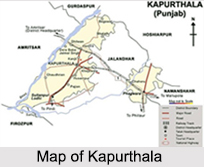 Kapurthala is a city in Punjab and is the administrative headquarters of Kapurthala District. It is also known as city of Palaces and Gardens. Kapurthala is situated towards the west of Jallandhar city at a distance of 19 kilometres in Punjab. Nawab Kapur Singh had founded Kapurthala. Kapurthala has a significant architectural legacy.
Kapurthala is a city in Punjab and is the administrative headquarters of Kapurthala District. It is also known as city of Palaces and Gardens. Kapurthala is situated towards the west of Jallandhar city at a distance of 19 kilometres in Punjab. Nawab Kapur Singh had founded Kapurthala. Kapurthala has a significant architectural legacy.
History of Kapurthala
Kapurthala was the capital of the Kapurthala State, a princely state in British India. It has an interesting history of maharajas, popular for their tastes in western fashion and trends. Among them, Maharaja Jagatjit Singh was regarded as one of the most enlightened Hindu princes of pre-independence times.
Demography of Kapurthala
According to the Census of 2011, Kapurthala has a population of 101,854, out of which males were 55,485 and females were 46,169. The literacy rate was 85.82 percent.
Tourism in Kapurthala
Kapurthala has a lot to offer to a tourist with its buildings and monuments related with the Maharajas. Some of them are mentioned below:
Villa Buona Vista: Villa Buona Vista, located on the banks of rivulet Bein was once the residence of the Maharajas. It is now a frequented picnic spot.
Sultanpur Lodhi: Sultanpur Lodhi is a place of religious importance. Guru Nanak Dev, the first Sikh guru spent the former years of his life here. The place has a host of Gurudwaras among which Gurdwara Ber Sahib is the most prominent.
 Sainik School: The Sainik School is a magnificent piece of architecture. This erstwhile palace of Maharaja Jagatjit Singh was designed by the French architect M. Marcel.
Sainik School: The Sainik School is a magnificent piece of architecture. This erstwhile palace of Maharaja Jagatjit Singh was designed by the French architect M. Marcel.
Shalimar Garden: Shalimar Gardens is a breathtaking site of cenotaphs of the former rulers of Kapurthala. Some of these cenotaphs embellished with exquisite Filigree work are a visual treat. The gardens also locate “Baradari†– a historical building which was the meeting point of Maharaja Ranjit Singh and Maharaja Fateh Singh.
Moorish Mosque: It was built by His Highness Jagatjit Singh and designed by the famous French architect M. Manteaux. Patterned after the Qutbya Mosque in Morocco, it is a brilliant masterpiece of Moorish style architecture.
State Gurudwara: It is situated in the center of the city on Sultanpur road. It was built by Maharaja Jagatjit Singh under the charge of Revail Singh.
Nihal Palace: Built by His Highness Raja Nihal Singh in the year 1840, the palace stood for architectural elegance. A beautiful Shish Mahal formed part of the palace earlier. Now only the remains of the palace exist and are famous as "Jallowkhana".
Mata Bhaderkali Temple: Built in 1885 by Sh. Thakur Dass Mehra, the temple houses the idol of Mata Bhaderkali.
 Kanjli Wetland: In the serene vicinity of rivulet of Bein is located, the Kanji Lake. It is a beautiful home of migratory birds in the winter. The place has the entire infrastructure for a great fishing and boating holiday for the tourists. The wetland extends over an area of about 50 acres and is a habitat for about 40 bird species. Kanjli was declared a wetland of national importance in 1992 for the rich biodiversity it supported.
Kanjli Wetland: In the serene vicinity of rivulet of Bein is located, the Kanji Lake. It is a beautiful home of migratory birds in the winter. The place has the entire infrastructure for a great fishing and boating holiday for the tourists. The wetland extends over an area of about 50 acres and is a habitat for about 40 bird species. Kanjli was declared a wetland of national importance in 1992 for the rich biodiversity it supported.
Randhir College: It is one of Punjab"s first education institutions. Maharaja Ranjit Singh in Kapurthala established it in 1856. It started as a leading Sanskrit institute. In 1896 it achieved the status of an intermediate college and in 1945 it was made a degree college.
Visiting Information of Kapurthala
Kapurthala boasts of a well developed rail and road network. Though it has no airport of its own, yet it is easily accessible from Amritsar airport.



















